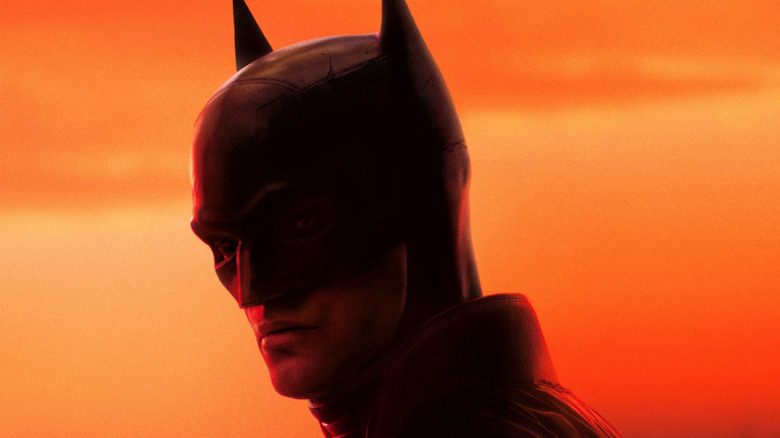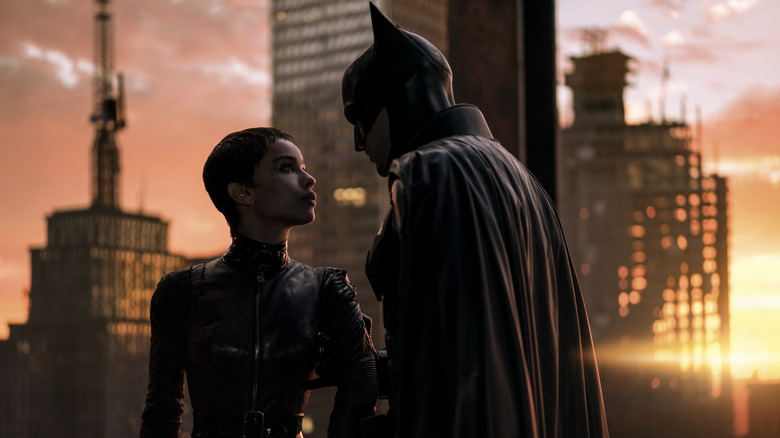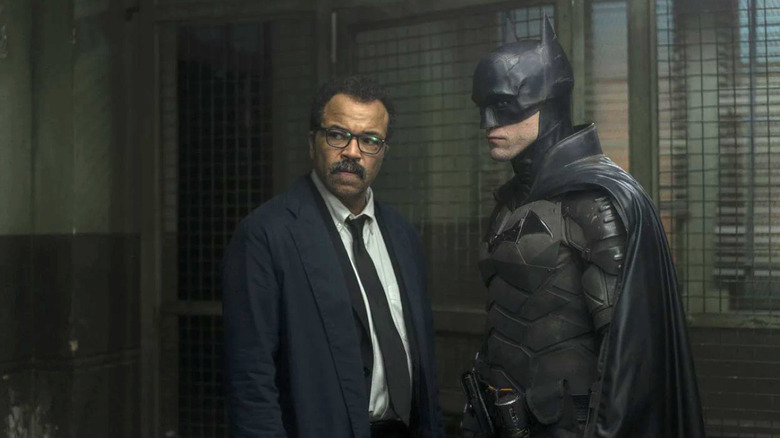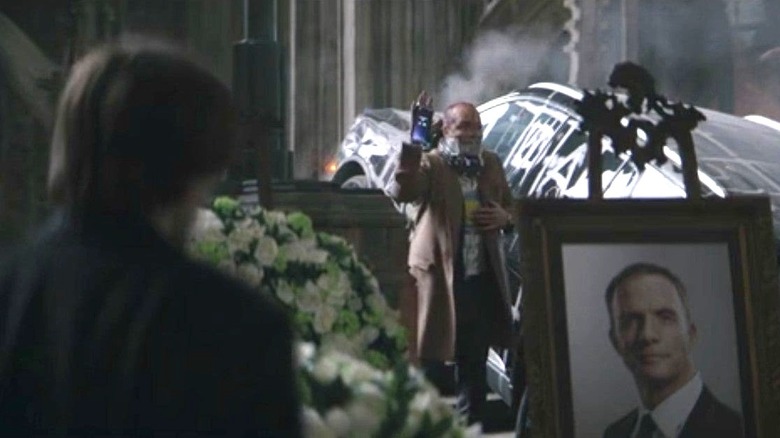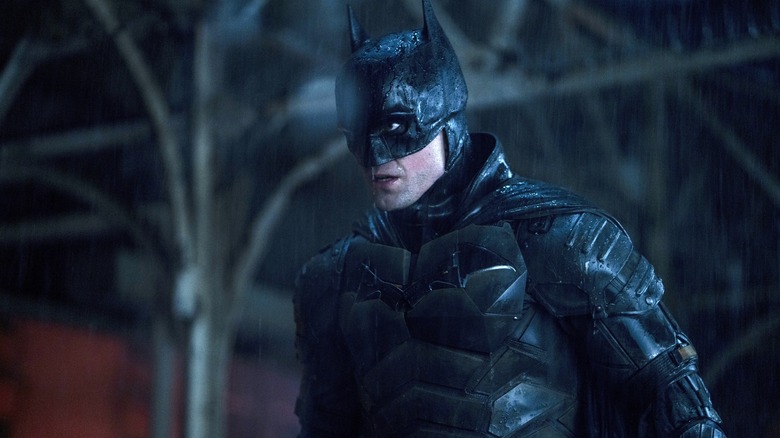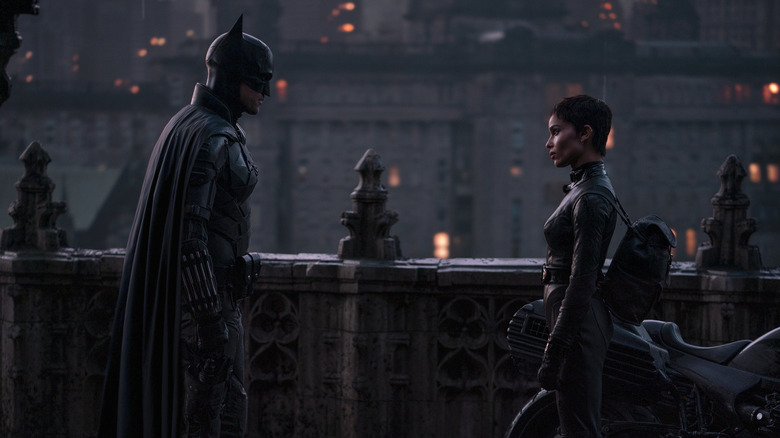The Biggest Plot Holes From The Batman
Clocking in at just under three full hours, "The Batman" is one of the longest comic book adaptations of all time. But where films like "Avengers: Endgame" have lengthy set pieces and endless crossover characters to juggle, this is a film whose length is largely the result of an intricate mystery plot. It's a narrative chock full of asides and diversions, a labyrinth of dark revelations for Batman to unravel.
Typically, movies that have to balance this many spinning plates tend to drop some of them, crashing the fine china plot specifics into shattered shards. "The Batman," written by director Matt Reeves and "The Town" scribe Peter Craig, handles this high wire act better than many recent entries into the genre, but as well know, no film is perfect.
Despite possessing a thrilling and satisfying story in its foundations, "The Batman" does still leave a handful of inadequacies that could be described as plot holes in its wake. We're here to run through them and try to piece together what was left from the finished product.
Seeing through Selina's eyes
In interviews describing his approach to making Batman a more grounded character on the big screen, Matt Reeves may have accidentally led fans to believe he was eschewing some of the more fantastical elements of the mythology in an effort to "out-realism" Christopher Nolan. But within the film's first few scenes, we can see that isn't exactly the case.
When Bruce arrives home from a night of crimefighting, he takes his contact lenses out to reveal that they're actually extremely thin and tiny digital video cameras. He downloads data from them on a nightly basis to revisit the details of his work when updating his ongoing diary and case files. Bruce repurposes this tech later in the film when he needs Selina Kyle (Zoë Kravitz) to infiltrate 44 Below, the club within a club at the Iceberg Lounge.
Through Selina's eyes, Bruce is able to see all the crooked cops and politicians who regularly haunt this secret mob hangout, but when he needs her to press District Attorney Gil Colson (Peter Sarsgaard) on the mysterious informant he references, Selina runs off to chase a lead about her missing friend Anika. When she and Bruce argue, she angrily pries the camera lens from her eye and tosses it into a sink, severing the connection.
However, much later in the film, when Selina needs a way to communicate with Batman, suddenly the discarded lens makes a reappearance, with one of Selina's many cats in the frame and a handwritten note saying "where are you?" She uses the connection to meet up with Bruce. But how does she do this?
In the initial scene, she hastily disposes of the lens, with the feed fizzling out in a way that heavily suggests it's damaged. From there it jump cuts to her storming out of the Iceberg Lounge to get a taxi. Nothing about this sequence gives the implication that she saved it for later, or that it's a piece of tech you can just throw in a purse and keep safe for future use.
But it is a convenient way to link these two characters back up at a crucial juncture in the plot, so maybe we'll give them a pass for this one.
Where does he get those wonderful toys?
Speaking of mysterious gadgetry, "The Batman" differs from Nolan's Dark Knight trilogy in another key way. There is no Lucius Fox — no Q, in James Bond vernacular — to outfit Bruce with all the wonderful toys he utilizes in his war on crime. Some elements are self-explanatory. It's clear, from the design alone, that Bruce has made the Batsuit himself, and some of the more rudimentary tools he deploys are simple enough. We don't need to know where he got a grappling hook, or a flare, or a syringe full of adrenaline.
But the aforementioned digital video contact lenses? The glider armor he uses to escape the roof of the GCPD building? Some of the computer tech in the Bat-cave? We have to essentially accept that, just like other adaptations, all this stuff comes from some unseen Wayne Enterprises R&D division, even if that answer is unsupported by the casual way Bruce insists he doesn't care about the company or anything that goes along with it. Or, perhaps, we're meant to just intuit that this world, this vision of Gotham, though grounded in reality, exists in a world ever so slightly more advanced than our own.
How many times did the Riddler call that phone?
In one of the film's most tense moments, D.A. Colson (literally) crashes the Mayor's funeral, with his mouth duct-taped shut, a smartphone affixed to his hand, and a bomb strapped around his neck. The GCPD has to treat it like a hostage situation, clearing out the chapel and leaving Colson in there while a bomb squad waits outside. But from the moment Colson arrives with the bomb, the smartphone is ringing. It's obviously the Riddler calling to begin the game show/Jigsaw antics that unfold in the next scene.
But a significant chunk of time passes between Colson arriving and Batman answering the phone. Day literally turns to night. Are we to believe the Riddler was holed up in his murder lair button mashing "redial" for hours on end? Like, sure, he's a dramatic individual and there's a great deal of theatricality to his quest for justice, but that is truly an utterly hilarious image to have in one's mind at such a nail-biting point in the narrative.
The cops probably wanted to err on the side of caution and worried answering the phone would be the detonator trigger for setting it off, so it makes sense. But somewhere between the 42nd ring and the 43rd, do we think the Riddler was second-guessing the efficacy of this particular part of his larger plan? Or did he foresee the hours he would spend redialing the same number over and over?
Quick change artist
Speaking of costume design, one of the most interesting elements of "The Batman" is how for the first time in live action, the Batsuit looks like something Bruce could have conceivably made himself, as it feels less like a giant mass of rubber molded into fake musculature and more like an assemblage of padding, armor, and utility gear. But there's one key element of the plot that keeps recurring throughout and makes it harder and harder to suspend disbelief.
In multiple scenes, Bruce is shown walking around or riding his motorcycle in street clothes, carrying a smallish backpack. The suggestion here being that he doesn't go into the city at night dressed as Batman, but that he begins most of his nights dressed anonymously before making the outfit change into his safer, armored look. But save for one very quick and very murky series of shots early in the film, we never see the process of what it's like to put on the uniform. It appears far too bulky and elaborate to fit into an average consumer-grade backpack, even though we're meant to surmise each time that Bruce is ducking into alleyways and returning from the shadows enshrouded in his war paint, ready to fight the good fight.
This inconsistency is at odds with how sharp the rest of the film is and how much verisimilitude there otherwise is in the overall creation and execution of Matt Reeves' vision. All that's missing is a Sailor Moon transformation dance.
I'm vengeance
This oft-quoted line from the first teaser released for "The Batman," first spoken in the character's first onscreen appearance during a fight with a gang of face-painted thugs, proves to be an important declaration for the themes the film goes on to explore. It returns as a callback in two separate scenarios — first playfully, then in a more damning form.
When Selina first meets Batman, the Penguin refers to him as "Mr. Vengeance here," leading Selina on more than one occasion throughout the film to flirtatiously refer to him as variations of the same. It's a cute and shrewd way to undercut that she's one of the only figures in the film who trusts Batman and is unafraid of his thorny aura.
The other, more haunting echo of this line comes in the film's climax, when Bruce must be pulled off one of the Riddler copycats after violently throttling him. Gordon unmasks the man and asks who he is supposed to be and, while making direct eye contact with Bruce, he responds by repeating "I'm vengeance." It shakes Bruce to his core, realizing that "fear and a little focused violence" are the tools of villains and terrorists, and that if he's going to enact real change in Gotham, he needs to become something more.
The Riddler disciple saying this is a happy accident designed to show the troubling similarity in their approaches. Selina calling Bruce "Vengeance" calls back to Penguin referring to Batman this way. But why did Penguin do it? He wasn't there when Bruce said that to the gang. It feels like a fourth wall-breaking moment to something the audience is privy to, but not the individual character.
Or, and this is somewhat weirder, it implies that Bruce says this so often to criminals he beats up that it's a running joke in the criminal community, something that would probably detract from his ability to instill fear, not enhance it. Perhaps a more thoughtful explanation is that there's a cut scene where he does say it around Penguin that would have made this make more sense. But either way, what a strange way to introduce yourself to others.
